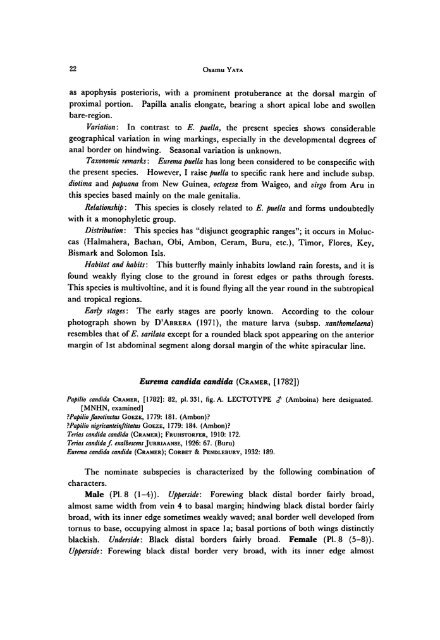A Revision of the Old World Species (Lepidoptera, Pieridae)
A Revision of the Old World Species (Lepidoptera, Pieridae)
A Revision of the Old World Species (Lepidoptera, Pieridae)
Create successful ePaper yourself
Turn your PDF publications into a flip-book with our unique Google optimized e-Paper software.
22 Osamu Yata<br />
as apophysis posterioris, with a prominent protuberance at <strong>the</strong> dorsal margin <strong>of</strong><br />
proximal portion. Papilla analis elongate, bearing a short apical lobe and swollen<br />
bare-region.<br />
Variation: In contrast to E. puella, <strong>the</strong> present species shows considerable<br />
geographical variation in wing markings, especially in <strong>the</strong> developmental degrees <strong>of</strong><br />
anal border on hindwing. Seasonal variation is unknown.<br />
Taxonomic remarks: Eurema puella has long been considered to be conspecific with<br />
<strong>the</strong> present species. However, I raise puella to specific rank here and include subsp.<br />
diotima and papuana from New Guinea, oclogesa from Waigeo, and virgo from Aru in<br />
this species based mainly on <strong>the</strong> male genitalia.<br />
Relationship: This species is closely related to E. puella and forms undoubtedly<br />
with it a monophyletic group.<br />
Distribution: This species has "disjunct geographic ranges"; it occurs in Moluc<br />
cas (Halmahera, Bachan, Obi, Ambon, Ceram, Buru, etc.), Timor, Flores, Key,<br />
Bismark and Solomon Isls.<br />
Habitat and habits: This butterfly mainly inhabits lowland rain forests, and it is<br />
found weakly flying close to <strong>the</strong> ground in forest edges or paths through forests.<br />
This species is multivoltine, and it is found flying all <strong>the</strong> year round in <strong>the</strong> subtropical<br />
and tropical regions.<br />
Early stages: The early stages are poorly known. According to <strong>the</strong> colour<br />
photograph shown by D'Abrera (1971), <strong>the</strong> mature larva (subsp. xanthomelaena)<br />
resembles that <strong>of</strong> E. sarilata except for a rounded black spot appearing on <strong>the</strong> anterior<br />
margin <strong>of</strong> 1st abdominal segment along dorsal margin <strong>of</strong> <strong>the</strong> white spiracular line.<br />
Eurema Candida Candida (Cramer, [1782])<br />
Papilio Candida Cramer, [1782]: 82, pi. 331, fig. A. LECTOTYPE ^<br />
[MNHN, examined]<br />
?Papilio flavotinctus Goeze, 1779: 181. (Ambon)?<br />
?Papilio nigricanteinftitatus Goeze, 1779: 184. (Ambon)?<br />
Terias Candida Candida (Cramer); Fruhstorfer, 1910: 172.<br />
Terias Candidaf. exalbescens Jurriaanse, 1926: 67. (Buru)<br />
Eurema Candida Candida (Cramer); Corbet & Pendlebury, 1932: 189.<br />
(Amboina) here designated.<br />
The nominate subspecies is characterized<br />
by <strong>the</strong> following combination <strong>of</strong><br />
characters.<br />
Male (PI. 8 (1-4)). Upperside: Forewing black distal border fairly broad,<br />
almost same width from vein 4 to basal margin; hindwing black distal border fairly<br />
broad, with its inner edge sometimes weakly waved; anal border well developed from<br />
tornus to base, occupying almost in space la; basal portions <strong>of</strong> both wings distinctly<br />
blackish. Underside: Black distal borders fairly broad. Female (PI. 8 (5-8)).<br />
Upperside: Forewing black distal border very broad, with its inner edge almost
















